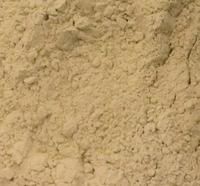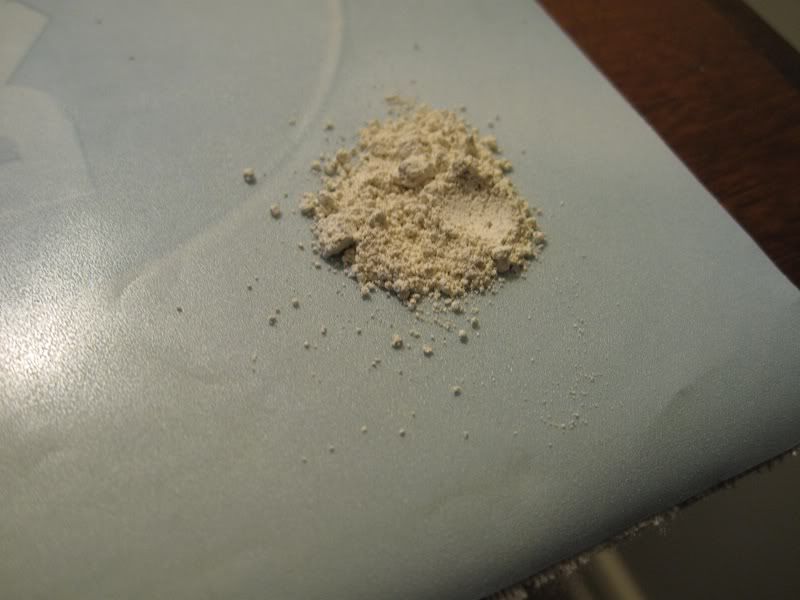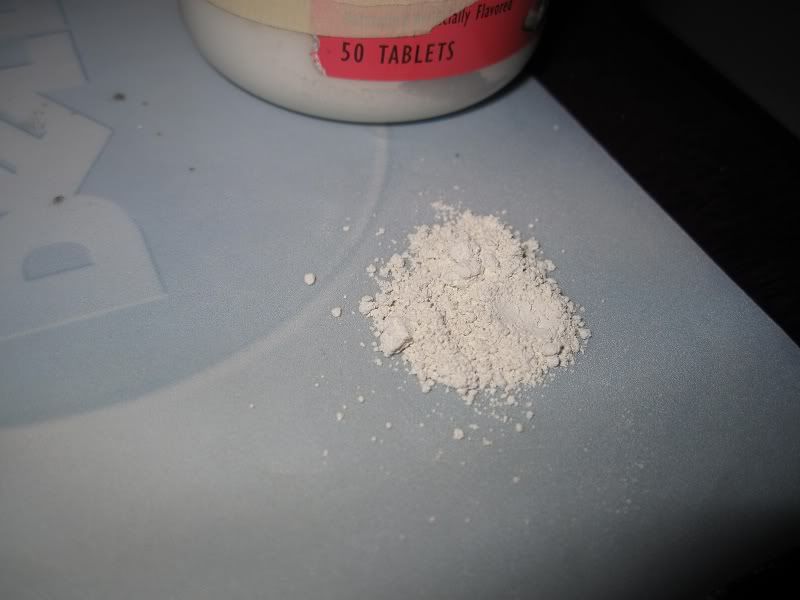Gary White gave me some powder to put onto my bone (off white) hat to fix problem blemishes.
Aureliano, I asked him what is was.
He said it is a trade secret. One that he mixes himself. He keeps secrets but also teaches hats at some school around there. Go Figure.
I suspect that it is nothing more than Fullers Earth powder (powdered Magnesium Aluminum Silicate) with a little powdered dye of the same color of the dyed hat body. I just ordered some and intend to try it to see if my hunch is true. Get it at drug stores or ebay.
Fullers Earth description:
Fullers Earth
AKA: whitening clay
Active Compounds: silica, alumina, iron, lime, magnesia, oxides, water
Background: Fullers earth is a type of clay that has many uses. It has properties that allow it to absorb oil. This has made it useful in industry where it's been used to soak up automotive oil and grease. It's also been used as a component of cat litter.
The name of fullers earth comes from the people who were the first to capitalize on its use. Laborers who processed wool used it to soak up the oil from the sheep. These workers were called "fullers" and that's where the clay gets its name.
While fullers earth is often use in industrial work, it can also be very useful for the skin. It's used in masks to help absorb oils and prevent acne. In order to use fuller's earth for these applications, it should be part of a special blend. Do not attempt to use the clay that's available for industrial use.
Applications: Lightener/Oil Absorption
Fullers earth is primarily used to promote healthy skin.
Oil absorption: Fullers earth can be added to facial masks and used to remove oils from the skin.
Skin lightening: Fullers earth can be used to lighten the skin.
Description:
Fullers earth is a mineral clay that's found abundantly in the world.
Fullers Earth Dosage:
Fullers earth can be applied to skin when mixed with other minerals. Follow the manufacturer's instructions on the product label.
Safety:
There is no negative information available for fullers earth. Consult your health care provider before beginning use of any herb.
You can see a picture of Fullers Earth here:

This is the powder that GW gave me, he wrote on the bottle "Bone Finishing Powder"
It looks like this:


It is very very fine. If you dab your dry finger onto the powder it will stick to your finger.
Aureliano, I asked him what is was.
He said it is a trade secret. One that he mixes himself. He keeps secrets but also teaches hats at some school around there. Go Figure.
I suspect that it is nothing more than Fullers Earth powder (powdered Magnesium Aluminum Silicate) with a little powdered dye of the same color of the dyed hat body. I just ordered some and intend to try it to see if my hunch is true. Get it at drug stores or ebay.
Fullers Earth description:
Fullers Earth
AKA: whitening clay
Active Compounds: silica, alumina, iron, lime, magnesia, oxides, water
Background: Fullers earth is a type of clay that has many uses. It has properties that allow it to absorb oil. This has made it useful in industry where it's been used to soak up automotive oil and grease. It's also been used as a component of cat litter.
The name of fullers earth comes from the people who were the first to capitalize on its use. Laborers who processed wool used it to soak up the oil from the sheep. These workers were called "fullers" and that's where the clay gets its name.
While fullers earth is often use in industrial work, it can also be very useful for the skin. It's used in masks to help absorb oils and prevent acne. In order to use fuller's earth for these applications, it should be part of a special blend. Do not attempt to use the clay that's available for industrial use.
Applications: Lightener/Oil Absorption
Fullers earth is primarily used to promote healthy skin.
Oil absorption: Fullers earth can be added to facial masks and used to remove oils from the skin.
Skin lightening: Fullers earth can be used to lighten the skin.
Description:
Fullers earth is a mineral clay that's found abundantly in the world.
Fullers Earth Dosage:
Fullers earth can be applied to skin when mixed with other minerals. Follow the manufacturer's instructions on the product label.
Safety:
There is no negative information available for fullers earth. Consult your health care provider before beginning use of any herb.
You can see a picture of Fullers Earth here:

This is the powder that GW gave me, he wrote on the bottle "Bone Finishing Powder"
It looks like this:


It is very very fine. If you dab your dry finger onto the powder it will stick to your finger.